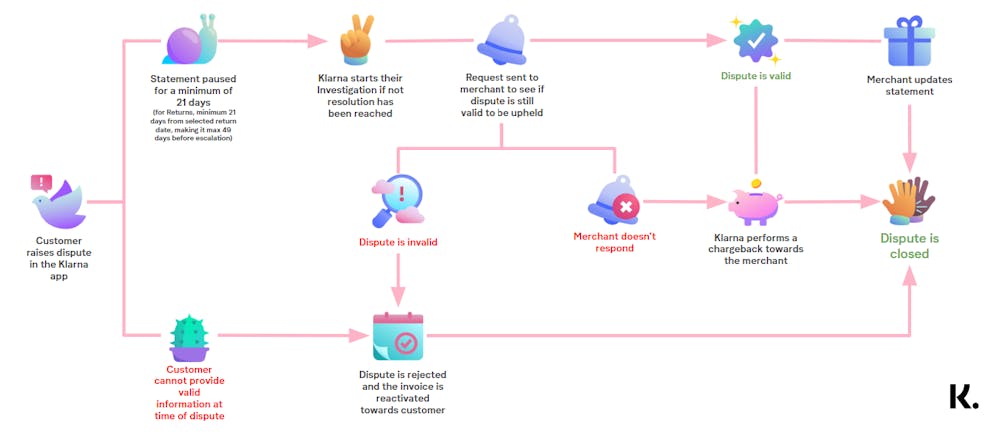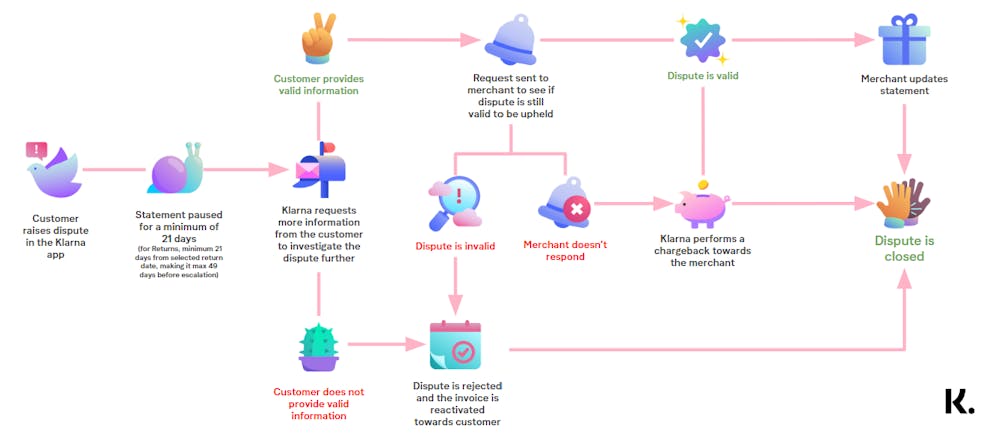In this article, you will learn how Klarna handles and resolves disputes and returns.
At Klarna we consider a dispute as to any case where the customer challenges their liability to pay to you.
Once a customer reaches to Klarna to open a Dispute they will be immediately guided to reach out to you for resolution before any intermediation from Klarna.
Disputes are categorised into different dispute reasons.
- Returns - a Customer returns the full or a part of their order. More information about Klarna´s Return Instruction can be found here.
- Goods not received - a Customer did not receive full or parts of their order
- Faulty goods - a Customer received an item that is broken, parts of it are missing or deviate significantly from the description. For information about what qualifies as ´Significant deviation´, please see our Merchant Protection Program
- Incorrect Invoice - a customer claims to have received an invoice that is incorrect, for example, missing discounts or items on the invoice are incorrect
- Unauthorized purchases - a customer reports they have never made the purchase
- High-risk orders are not considered to be actual disputes, since these are not raised by our customers. These orders have been identified as potentially high risk, based on Klarna's internal alarm and flagging systems, set in place to protect you from potential fraudulent activities.
Due to the nature of returns there is a separate flow for this dispute type as well as for unauthorized purchases.



The following sections details the steps to review and resolving disputes
When a customer opens a dispute with Klarna, we will automatically pause the invoice and advice the customer to:
- Return the items in case of returns
- Reach out to you in case of other dispute reasons (goods not received, faulty goods and incorrect invoice)
Following that, we ask the customer to provide us with the necessary information to raise a dispute.
The time period for you and your customer to resolve the dispute before Klarna steps in to support the investigation is called Resolution time.
Depending on the reason assigned, after a customer reports a dispute to Klarna you will have a defined Resolution time to resolve the case directly with the customer and with no additional intermediation from Klarna.
If the dispute was not resolved within the Resolution time you will receive a request for more information where you can defend the dispute.
All disputes are visible in the Disputes App and via the API once they have been raised by the customer. See Disputes App in Merchant Portal for more information.
| Dispute reason | Calendar days* |
|---|---|
| Returns | 21 |
| Goods not received | 21 |
| Incorrect invoices | 21 |
| Faulty goods | 21 |
| Already paid | 21 |
| Unauthorized purchases | N/A |
*This rule may not apply in some cases.
If you and the customer can not reach a solution on your own within the given Resolution time, Klarna will step in to investigate.
We first will evaluate the
Request deadline
A dispute request is always sent with a deadline, indicating until when you are able to submit a response for the requested information. The deadline for the request follows these guidelines:
- First request for Unauthorised Purchases up to 7 days (168 hours).
- First request for all other dispute reasons up to 14 days (336 hours).
- For each follow-up request sent to you, you have a deadline of 7 days (168 hours).
Once the deadline has passed you will no longer be able to defend the case.
In case you require to add additional information to a submitted response you have 60 minutes from submission to send an additional comment and/or attachment.
After receiving the necessary information from you, the merchant, Klarna’s support team will make a decision and resolve the dispute.
- If the dispute is resolved in favor of the customer, you will receive a chargeback
- If the dispute is resolved in your favor, the customer’s invoice will be re-activated.
Once finalise the outcome of the Dispute processing will be communicated to you via the "Status" and "Closing Reason" visible on the Dispute Detail Page of the Dispute App. On the same page you can locate the date and time when the dispute was resolved.
The status indicates in
Rejected
When a customer has not provided the required evidence to proceed with the dispute it will be rejected. If there is information that is deemed incorrect or missing Klarna will reject the dispute before escalation, meaning Klarna will never start the investigation towards you.
There are instances where Klarna’s Dispute Resolutions Team needs additional information from the customer following a response from you. If the customer fails to provide it before the deadline, the dispute is also rejected. In the event of a rejection the invoice is reactivated towards the customer and payments will resume.
Resolved
When the dispute has been closed either due to natural proceedings or in favor of you.
When a dispute is resolved the invoice is either adjusted by you or reactivated towards the customer and payments will resume.
Reversal
When the dispute has been closed in favor of the customer and Klarna has performed a Chargeback to you on the order. This happens if you have not been able to effectively defend the dispute or chosen not to defend the dispute (Accept Loss or no response).
The Closing Reasons are very important. They explain the reasons for the resolution of the closed dispute.
In addition: The Closing Reason determines whether or not the Dispute fee will be applied after a dispute is closed. Read more about Closing Reasons here.
Klarna has imposed restrictions on when and how many times customers are allowed to dispute and re-dispute an order.
Unauthorized Purchases are excluded.
To prevent users from abusing the dispute option Klarna will allow the customer to raise a maximum of three disputes total per order.
For example - A total of two non-return disputes per order (Goods Not Received, Incorrect Invoice, Faulty Goods) and one Return.
| Dispute type | 1st dispute |
|---|---|
| Returns | 180 days (from capture) |
| Goods not received | 180 days (from capture) |
| Incorrect invoice | 180 days (from capture) |
| Already paid | 180 days (from capture) |
| Faulty goods | 180 days (from capture) |